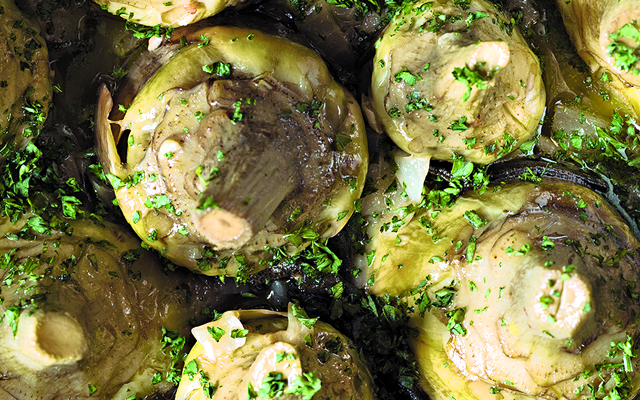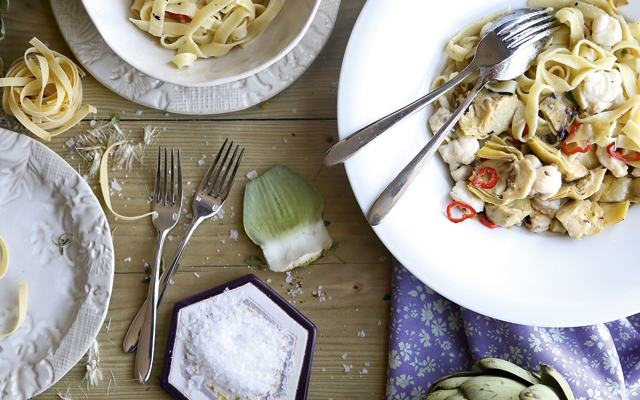Two delicious artichoke recipes
Simon Hopkinson has two delicious ways to enjoy the new season’s artichokes.


I will forever remember my first visit to Harry’s Bar, Venice, in a very wet early spring, 1989. Friends and I had arranged to meet there for early-evening martinis. To be irritably frank, I was disappointed that we weren’t going to follow drinks with dinner there as well, but the full cost of a Harry’s dinner could not be agreed by all participants as, how shall we say, a reasonable expense.
They had a point, as anyone who has nudged open those legendary, narrow, snappy doors into the best bar in the world knows full well that dinner may well eclipse the cost of a night’s board and lodging—and, by that, I don’t mean a small room in simple albergo.
Be that as it may, I would have been up for it and hang the expense. However, this was further exacerbated by our party being placed next to a couple and their young daughter at a favoured corner table and, just as our deliciously chilled and wonderful drinks were placed before us (truly, they are the finest martinis ever mixed), delivered to them was a small plate of the tiniest stewed artichoke hearts I had ever seen.
There were only nine of them, each the size of the very earliest Jersey potato, utterly unadorned, but with the merest dribble of oily cooking juices seeping onto the plate. As their scent wafted over to us, I realised they were served just warm from the cooking pot, so I asked the waiter about these little beauties. ‘Ah,’ he said, clearly delighted, ‘those are the castraure.’
During March and April, the very first of the seasonal tiny, tender artichokes are almost exclusively harvested from islands within the lagoon. They appear as little buds, which are then cut out from the very centre of the leafy plant (castraure: literally ‘taken out from’, although ‘castrated’ must surely be considered in translation somewhere along the way?) before they become too prominent.
As a result of this premature removal, as many as a dozen or more larger artichokes will further flourish as the season continues. Not only did the Venetians construct an impossible city, but they knew their vegetables, too.
Now, I have never seen these diminutive artichokes appear in discerning British greengrocers, but Italian bunched artichokes (usually as a purply-green bouquet of five) are most definitely an imported delight in early springtime.
Exquisite houses, the beauty of Nature, and how to get the most from your life, straight to your inbox.
They are not the cheapest choice, greenery-wise, at this time of the year, but no more costly than our more northerly, home-grown asparagus spears. And then, as with our asparagus into May and early June, prices will diminish.
The preparation of these smaller, bunched artichokes is different to that of the large, olive-green globe artichokes usually sent from northern France, and from Brittany in particular. The latter are usually trimmed a little, boiled in copious amounts of salted water and eaten whole, using the fingers to remove the leaves of the artichoke and dipping them into a vinaigrette dressing.
Lovely as these are—and as the opener to a long summer lunch, I cannot think of many better—their more slender, tender cousin offers an opportunity to the more adventurous—the more curious cook, perhaps.
Simon Hopkinson is the founding chef and co-proprietor of Bibendum restaurant, London.
Artichokes ‘barigoule’ (serves 2)
Ingredients Juice of 2 lemons 4tbspn best olive oil 2 thick slices unsmoked bacon (or pancetta), diced 1 onion, diced 2 cloves garlic, finely chopped 250ml white wine 150ml water 2 bunches purple-leafed artichokes (usually sold in bunches of five), prepared as directed below Salt 1–2 small dried red chillies, to taste, crumbled 1 heaped tbspn finely chopped parsley
Method To prepare the artichokes for this delicious, southern French dish, first prepare a large bowl filled with water, into which the juice of one of the lemons should be added. Now, remove any leaves as well as an excess of stalk from each artichoke, so leaving about 4cm attached to each one.
Using a sharp, stainless-steel serrated knife (a carbon-steel knife will both blacken the knife and, further, stain the flesh of the plant), horizontally cut through the leaves of the artichoke, roughly measuring about 2cm–3cm from the top, depending on size. Discarding these, begin to snap off the darker leaves of the artichoke until the tender, more pale and creamy leaves are revealed. Using a potato peeler, now remove the skin of the stalk, working down from the base of the artichoke, rotating the bud in your hand as you go.
As each artichoke has been prepared in this fashion, drop it into the bowl of water acidulated with the juice of two lemons (this helps prevent discoloration) and then they’re ready to cook.
To prepare the ‘barigoule’, take a shallow pan (of a width that will contain the artichokes snugly) that also has a lid, then add the olive oil and bacon. Allow to cook together until the bacon begins to gild lightly.
Stir in the onion and garlic, turn the heat down to very low and put on the lid. Stew the mixture for at least 10–15 minutes, stirring occasionally.
Add the white wine and water and bring up to a boil for five minutes, uncovered. Put in the artichokes, stems uppermost, sprinkle with the salt and chillies and bring up to a simmer. Cover once more and cook for 10 minutes. Now, remove the lid and briskly cook for a further 15 minutes or so, until the artichokes are tender when pierced with a sharp knife and the liquid has reduced until syrupy.
Sprinkle with the parsley and leave the dish until lukewarm before eating. Artichoke soup with black truffles (serves 4)
Ingredients See above recipe 200ml double cream Black truffles Method This is an indulgent and extra-vagant soup. However, with all such things, occasionally is the way to think. The way to make the soup simply requires the above recipe without using the bacon and chillies, but adding some cream.
So, this time, simply stew the onions and garlic in the olive oil and then continue the recipe until you add the artichokes.
Now, gently simmer the artichokes, covered, for at least 30 minutes, or until very tender indeed—if not a touch over-cooked and slightly collapsing, even.
Liquidise the contents until very smooth, then pass the purée through a fine sieve into a bowl and whisk in 200ml of hot double cream. Correct the seasoning and, if the texture is too thick, dilute with a little hot milk or boiled water.
Decant into warmed soup plates and shave as much black truffle over them as you dare. Note: do not serve the soup too hot, as the flavour is delicate.

Cooking with globe artichokes
Steamed and served with a lemon and Parmesan dressing, or chargrilled and stirred into tagliatelle with monkfish: just two of

8 British drinks to try this Easter
Olivia Williams rounds up the very best of British drinks to try this spring.
